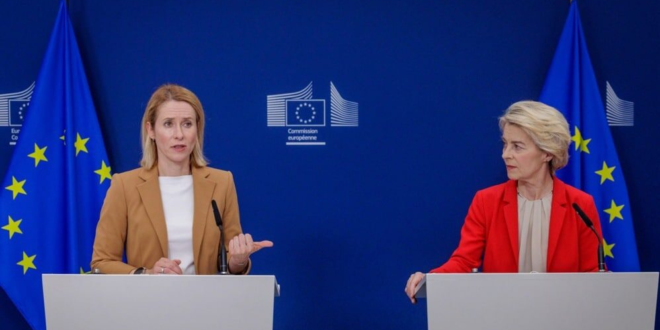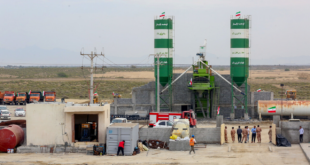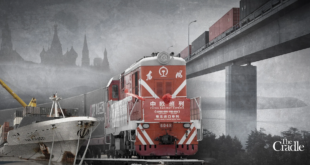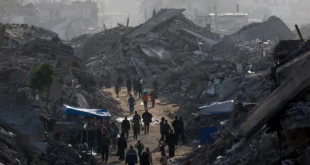As the EU unveils its 18th package of sanctions against Russia, calls are growing to provide Ukraine with the 300 billion dollars of frozen Russian state assets. How feasible and impactful would such a move be?
A showdown between the EU and the bloc’s two most pro-Russian members, Hungary and Slovakia, over the new round of sanctions against the Kremlin is expected at the next EU leaders’ summit in Brussels on June 26-27.
Unveiled on June 10 by European Commission President Ursula von der Leyen, the proposed round of sanctions, the 18th since Russia’s full-scale invasion of Ukraine in 2022, include proposals to lower the global price cap on Russian oil from 60 to 45 dollars per barrel; ban transactions with Russia’s Nord Stream gas pipelines that run between Russia and Germany; cut off another 22 Russian banks from the SWIFT international banking system; and impose a “transaction ban” on “financial operators in third countries that finance trade to Russia, in circumvention of sanctions.”
There is also EU legislation in the works that would finally put an end to all European imports of Russian gas – pipeline and liquefied – by 2028.
Von der Leyen called the sanctions “robust” and “hard-biting”, while Benjamin Schmitt, a senior fellow at the University of Pennsylvania’s Kleinman Center for Energy Policy and Perry World House, said the measures would go some way to “finally ending Russia’s energy grip over European political and security interests”.
Yet these sanctions are only proposals and must be agreed unanimously by all 27 member states at the next European Council later this month. So far, Hungary and Slovakia have already registered their opposition.
Though both these countries have agreed to the previous 17 rounds of sanctions, they have done so grudgingly and with threats to delay or veto them for political leverage until their demands were met.
Slovakia, for example, has done little to reduce its dependency on Russian pipeline gas and the country’s prime minister, Robert Fico, warned on Facebook that he would block additional sanctions unless the bloc finds “a real solution to the crisis situation that Slovakia would face following a complete halt in the supply of gas, oil, and nuclear fuel from Russia.”
Hungarian Prime Minister Viktor Orban has also spoken out against imposing more sanctions on Russia, and in the past used his threat to veto them unless the EU releases budget funds for Hungary that have been suspended over its rule-of-law infractions. This proved a successful approach at the end of 2023.
The messy compromises required to get sanctions approved and extended – the sectoral sanctions will come up for renewal again at the end of July, while the listings of individuals and institutions will be reviewed in September – and questions about their effectiveness after 17 previous rounds have led to growing calls to confiscate the roughly 300 billion dollars in frozen Russian sovereign assets, primarily foreign currency reserves accumulated by the Central Bank of Russia (CBR), in order to pay reparations to Ukraine for the Kremlin’s illegal invasion. This action, unlike the EU sanctions, would not be subject to the unanimous agreement of EU member states; the governments of each would choose whether to confiscate any Russian state assets held in their country.
“We’ve done this [imposed sanctions] 17 times now… and we’re starting to run out of targets. It’s a bit like that game Whac-A-Mole – the Russians keep finding workarounds,” John Lough, head of foreign policy at the New Eurasian Strategies Centre, tells BIRN. “I’m a bit of a sanctions sceptic… Sanctions are a thing you do when you can’t think of anything better to do.”
Reparation loan
The lion’s share of the frozen Russian state assets, 212 billion euros’ worth, is held at Euroclear, a securities clearinghouse in Belgium, which “immobilised” the funds following Russia’s invasion of Ukraine in February 2022. The UK holds 25 billion pounds; the US another 5 billion dollars.
With the US unwilling to continue funding Ukraine’s defence against Russian aggression and Europe unable to meet the shortfall, meaning Ukraine could run out of money later this year, using those frozen state assets as reparations for Ukraine would help resolve this dilemma, as well as arguably put more pressure on Vladimir Putin to agree a ceasefire and peace deal.
“This [300 billion dollars] would support Kyiv’s budgetary needs for approximately another three years at its current spending rate – with no economic cost to either US or European taxpayers,” point out Hugo Dixon and Lee Buchheit, in a report for the American Enterprise Institute prepared earlier this year. “Threatening to use the assets in this way would give Ukraine and its allies leverage in the talks with Russia. Putin would realise Ukraine had the cash to withstand a war of attrition.”
This “freeze to seize” of Russian state assets has already been tested by the West in a limited fashion. In July 2024, the first payment of 1.5 billion euros in interest that had accrued on the Russian assets held via Euroclear was paid to Ukraine. In its 2024 annual report, Euroclear disclosed that it earned approximately 6.9 billion euros in interest on the cash balances arising from sanctioned Russian assets.
Legal experts broadly agree that Euroclear – and other central securities depositories (CSDs) – has neither any obligation nor even the legal ability to remit this accrued interest to Russia, thus it accrues to Euroclear itself in what the EU describes as “extraordinary” or “windfall” profits.
The EU is now looking into transferring almost 200 billion euros of those frozen Euroclear funds into a “special purpose vehicle” that would invest in riskier assets paying out higher returns, Politico on Thursday reported four officials with knowledge of proceedings as saying.
Another step in using these frozen assets to fund Ukraine’s defence came in October 2024, when the G7 agreed an extraordinary revenue acceleration (ERA) loan for Ukraine worth 50 billion dollars, which would use the interest accumulating on these frozen Russian assets for repayment.
Dixon and Buchheit argue this should be taken a step further. In their report, they argue for a “reparation loan” as a way for a coalition of willing countries to speed up getting money to Ukraine, in return for Kyiv pledging as collateral future claims for war reparations.
Once the international claims commission, mandated by the UN general Assembly, has been set up to rule on Kyiv’s demands for compensation, they argue, Moscow either pays the reparations or loses its assets. “This mechanism avoids the problems associated with confiscating the assets,” the authors claim.
With the cost of rebuilding Ukraine already reaching 486 billion dollars, according to a World Bank estimate from February 2024, Ukraine’s allies could make a reparation loan for the full amount of the frozen state assets.
Straight to confiscate
Yet a growing number of legal experts and analysts argue that there are few legal issues associated with confiscating the assets; rather, it is more a matter of political will.
“With the weight of authority balanced but tilting towards the legality of seizure, it is difficult to escape the conclusion that, if G7 governments mustered the political will to act, no plausible challenge could be mounted against the international legality of a potential transfer,” wrote Anton Moiseienko, senior lecturer in law at Australian National University, on the legal blog site Verfassungsblog.
Estonia is the first to show a way forward with its 2024 law, which allows for the confiscation of assets belonging to individuals or entities that have been directly involved in or facilitated Russia’s unlawful actions in Ukraine. Once a claim under the frozen asset mechanism has been made and approved by the Estonian Ministry of Foreign Affairs, the asset owners have the right to contest the decision in an Estonian administrative court. Failing that, there would be a public tender of the frozen asset and the funds paid to Ukraine.
Aaron Gasch Burnett, a senior fellow and project manager with the Berlin-based think tank Democratic Strategy Initiative, is likewise opposed to the “reparation loan” idea, arguing there is no real alternative to simple, outright, full confiscation of the entire principal and transferring it to a “Ukraine Compensation Fund”.
“Ultimately, these ‘creative solutions’ are simply designed to avoid necessary political decisions – they’re a smokescreen,” he says. “Outright confiscation is simpler legally, economically and strategically – and carries far fewer risks, again, legally, economically and strategically. Proponents of ‘using’ the assets rather than ‘seizing’ them are, I believe, needlessly complicating what should be a simple solution,” Gasch Burnett tells BIRN.
He explains that under the legal principle of countermeasures, a state that is so fragrantly violating international law can’t then claim the protection of the same international law it is so grossly violating, he says.
In addition, states like Belgium and institutions like Euroclear that argue against the confiscation of the assets fall back on the argument that Russia could use sovereign immunity to challenge the seizure in court, leaving them at the mercy of such a case. Yet the G7 could show solidarity with Belgium by providing it with indemnification, a contractual promise to protect a body from financial harm, and thus collectify the risks. Gasch Burnett contends transferring the assets to a “Ukraine Compensation Fund” is the best way to provide Belgium with that indemnification.
In any case, Gasch Burnett wonders, in what court could Russia feasibly sue Belgium or any other state confiscating its assets? “The opinion that countermeasures are legal is supported by 11 international lawyers who have combined experience of over a century arguing cases before the ICJ [International Court of Justice],” he says.
The best argument for confiscation is that it removes the very real danger that a Hungarian or a Slovak veto when EU sanctions come up for extension every six months could see these hundreds of billions of dollars returned to Russia and used to finance its war machine. “Full confiscation is the only solution that removes this risk. This is why I believe these proposed compromises are frankly irresponsible,” he argues.
Might the threat of confiscation even persuade Putin to consider suing for peace instead? “My suspicion is that Putin has effectively already written off that 300 billion [dollars],” says John Lough of the New Eurasian Strategies Centre.
 Eurasia Press & News
Eurasia Press & News




